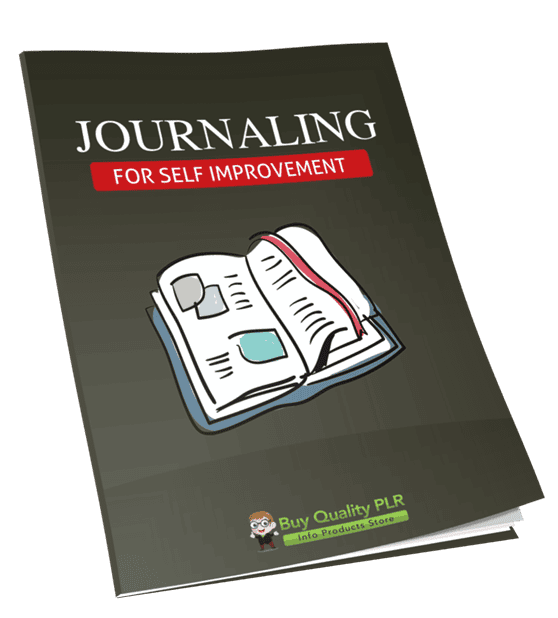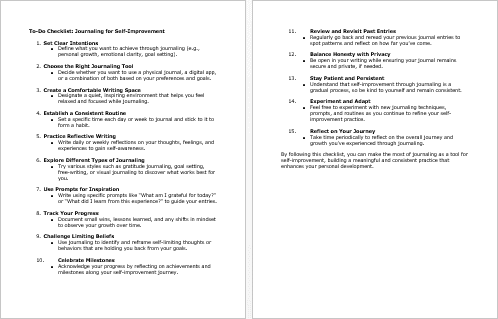
Journaling for Self Improvement PLR Course 28k words
in Journaling PLR , PLR Checklists , PLR eBooks , PLR eCourses , PLR List Building Reports , Premium PLR , Premium PLR eBooks , Premium PLR Reports , Premium White Label Brandable PLR Coaching Courses , Private Label Rights Products , Self Care PLR , Self Discipline PLR , Self Esteem PLR , Self Help PLR , Self Improvement PLR , Self Improvement PLR EbooksChoose Your Desired Option(s)
has been added to your cart!
have been added to your cart!
#journaling #selfimprovement #mindsetgrowth #personaldevelopment #mentalclarity #wellness #plrcourse #contentcreators #selfcare
Unlock the Power of Journaling and Transform Lives While Growing Your Online Business!
Are you looking for a ready-to-use, high-value product to offer your audience in the booming personal development niche? Imagine giving your customers a complete, step-by-step guide to self-improvement through journaling—while having the flexibility to sell, repurpose, or bundle it as your own product.
The Journaling for Self-Improvement PLR Course is a comprehensive, done-for-you package that contains everything you need to provide exceptional value while generating profits. With over 26,000 words of actionable content, this course is perfect for marketers, coaches, bloggers, and entrepreneurs who want to launch a high-quality product without starting from scratch.
Presenting…
Journaling for Self Improvement PLR Course 28k words
Why Journaling is the Ultimate Tool for Personal Growth
Journaling isn’t just writing—it’s a powerful tool for mental clarity, emotional balance, and personal development. Studies show that journaling can:
- Improve focus, organization, and decision-making skills
- Reduce stress, anxiety, and negative thought patterns
- Help users track progress toward personal and professional goals
- Build self-awareness, gratitude, and emotional resilience
With this course, your audience will gain practical skills to incorporate journaling into their daily lives, making it a habit that produces measurable improvements in mindset, productivity, and overall well-being.
What You’ll Get in This PLR Course
The Journaling for Self-Improvement PLR Course is divided into five detailed modules, each packed with actionable steps and exercises to help learners start journaling confidently and consistently:
Module 1: Getting Started with Journaling
- Discover the life-changing benefits of journaling and why it’s an essential tool for personal growth
- Learn how to choose the right tools, whether notebooks, journals, or digital apps
- Set up a comfortable and inspiring writing environment to maximize focus and creativity
- Establish a journaling routine that fits any lifestyle, ensuring consistency
Module 2: Exploring Different Types of Journaling
- Learn about different journaling styles, including gratitude journals, goal-setting journals, and free-writing
- Practice gratitude journaling to boost positivity and self-awareness
- Use goal-setting journaling to plan, track, and achieve personal and professional goals
- Tap into the subconscious through free-writing exercises, unlocking creativity and insights
Module 3: Writing Techniques for Deeper Insights
- Practice reflective writing to analyze daily experiences and emotions
- Explore prompt-based journaling, answering questions like “What’s holding me back?” and “What brings me joy?”
- Learn visual journaling techniques, combining sketches, doodles, and mind maps with written entries
- Develop the habit of reviewing past entries to identify patterns and track growth over time
Module 4: Overcoming Common Challenges
- Overcome the fear of starting and perfectionism that often prevents journaling
- Break through writer’s block with simple, practical strategies
- Stay consistent and motivated using habit trackers, reminders, or pairing journaling with other routines
- Balance honesty and privacy, keeping your entries secure while being candid
Module 5: Using Journaling for Personal Growth
- Set intentions and goals for self-improvement and track progress effectively
- Document small wins and lessons learned, building confidence and momentum
- Identify and challenge limiting beliefs, reframing negative thought patterns
- Celebrate achievements and reflect on the journey to recognize meaningful progress
By the end of this course, learners will have the tools and knowledge to turn journaling into a powerful, lifelong habit that drives personal growth and positive change.
Included Bonus Materials
To make this PLR course even more valuable, you’ll also receive:
- Journaling for Self-Improvement Checklist (378 words) – A step-by-step guide for users to track their journaling habits and stay consistent.
- Journaling for Self-Improvement FAQs (1,014 words) – Addresses common questions, concerns, and challenges for beginners.
- Journaling for Self-Improvement Salespage (817 words) – Ready-to-use copy to sell the course immediately on your website or platforms.
These bonus materials provide instant credibility, make your course more attractive, and save you hours of content creation time.
How You Can Use and Profit from This PLR Course
The flexible PLR license allows you to use this content in multiple profitable ways:
- Sell the full course as-is or with minor tweaks to make it your own
- Break the course into individual reports and sell for $10–$20 each
- Bundle with other products to create premium packages priced $47–$97
- Build a membership site and generate recurring monthly income
- Convert the content into a multi-week eClass to sell for $297–$497
- Create physical products, including workbooks, guided journals, or planners
- Produce audio or video versions for online courses or coaching programs
- Use excerpts as lead magnets, blog posts, or email content to grow your audience
- Flip a website with this course as the main product for a high-value resale
With this package, you get a ready-to-go, versatile product that can be monetized in multiple ways, all while saving months of content creation effort.
PLR License Terms – What You Can and Cannot Do
Permissions:
- Sell the course as-is (minor edits allowed)
- Substantially change 75% of the content to claim copyright
- Break it into reports, bundle with other content, or use in membership sites
- Convert into audio, video, or physical products
- Excerpt content for blogs, lead magnets, or email sequences
Restrictions:
- You cannot pass on PLR rights to your customers
- You cannot give the full course away for free in its current state
- You cannot offer 100% affiliate commissions (max 75%)
- You cannot add the course to existing customer orders without additional purchase
These restrictions protect the value of the product while giving you exclusive opportunities to profit.
Why This PLR Course is a Must-Have
- Ready-to-sell, done-for-you content that saves hours of work
- High-value niche in self-improvement and personal development
- Flexible license with multiple monetization opportunities
- Includes checklist, FAQs, and a sales page for instant selling
- Perfect for coaches, bloggers, marketers, and entrepreneurs
Take Action Today
Don’t spend months creating a high-quality personal development course from scratch. Start profiting immediately with this Journaling for Self-Improvement PLR Course and help your audience achieve mental clarity, emotional balance, and personal growth.
This is your opportunity to sell a high-value product, build authority, and generate income in a niche that’s in high demand.
Get your PLR course today and start empowering your audience while building your profitable online business!
has been added to your cart!
have been added to your cart!
Grab Your Journaling for Self Improvement PLR Course Now and Start Profiting!
Module 1: Getting Started with Journaling
Step 1: Understand the Benefits of Journaling
Discover how journaling can enhance your mental clarity, emotional well-being, and personal growth.
In this step, we will explore the powerful impact journaling can have on your life. By understanding its benefits, you’ll be inspired to commit to this transformative practice and make it an integral part of your daily routine. Let’s dive into the details step by step:
1. Journaling for Mental Clarity
When your mind feels cluttered, journaling acts as a tool to declutter your thoughts and bring clarity to your thinking.
Step-by-Step Process:
- Identify Mental Overload: Take a moment to notice when your thoughts feel scattered or overwhelming. For example, when you’re trying to solve a problem or manage multiple tasks.
- Write Freely: Begin by writing down everything on your mind—questions, worries, plans, or even random ideas. This is often called a “brain dump.”
- Organize and Prioritize: As you review what you’ve written, you’ll naturally begin to categorize and prioritize your thoughts. Highlight important points or create action lists.
Outcome:
Journaling creates a mental “reset,” helping you focus and make clearer decisions. Internationally, this is widely recognized as an effective technique for professionals juggling complex projects or personal challenges.
2. Journaling for Emotional Well-Being
Emotions can be overwhelming if left unprocessed. Journaling offers a safe, judgment-free space to explore and manage your feelings.
Step-by-Step Process:
- Acknowledge Your Feelings: Begin by asking yourself, “What am I feeling right now?” Write down your answer honestly, even if it’s difficult to articulate.
- Practice Emotional Release: Write about your emotions in detail. If you’re angry, explore the root cause. If you’re happy, describe what brought that joy.
- Reflect and Learn: After expressing your feelings, take a step back and read what you wrote. Reflect on patterns or triggers and consider how you might respond differently in the future.
Outcome:
By releasing pent-up emotions, journaling reduces stress and promotes emotional balance. Studies from multiple countries emphasize its role in improving mental health, making it a valuable tool for people from all walks of life.
3. Journaling for Personal Growth
Personal growth is a lifelong journey, and journaling accelerates this process by fostering self-awareness and intentional living.
Step-by-Step Process:
- Set Personal Goals: Write about what you want to achieve in the short and long term. Be specific, such as “learn a new language” or “build stronger relationships.”
- Track Progress: Use your journal to record milestones or challenges. For example, if your goal is to improve your health, jot down what’s working and what needs adjustment.
- Cultivate Gratitude: End each journaling session with gratitude. Write three things you’re thankful for—this shifts your mindset towards positivity.
Outcome:
Journaling becomes a powerful tool for self-reflection and intentional growth. Around the globe, high achievers—from entrepreneurs to athletes—credit journaling as a key to their success.
4. Evidence-Based Benefits of Journaling
Let’s briefly look at the science-backed benefits of journaling recognized internationally:
- Cognitive Benefits: Enhances focus, memory, and problem-solving skills.
- Stress Reduction: Proven to lower cortisol levels (the stress hormone).
- Improved Resilience: Helps individuals process trauma and develop coping mechanisms.
For example, research conducted at the University of Texas found that journaling for 15-20 minutes a day can significantly improve mental health and reduce stress levels over time.
5. How to Apply This Knowledge
- Practice Daily: Dedicate just 10-15 minutes each day to journaling. The benefits compound with consistency.
- Choose Your Format: Whether you prefer structured prompts or free writing, find a style that suits your needs.
- Reflect Often: Periodically revisit past entries. They serve as a mirror to your growth and provide insights into your journey.
By understanding the benefits of journaling, you’re not just creating a daily habit—you’re unlocking a tool that can profoundly enhance every aspect of your life. In the next steps, we’ll build on this foundation to turn your journaling practice into a transformative experience.
Step 2: Choose the Right Tools
Learn how to select a notebook or digital app that fits your style and needs.
Choosing the right tools for journaling is an essential step to ensure that your practice feels comfortable, enjoyable, and sustainable. The right medium enhances your motivation and aligns with your personal preferences and lifestyle. This step-by-step guide will help you decide between physical and digital options and customize them for your needs.
1. Decide Between Analog or Digital Journaling
The first decision to make is whether you prefer a physical notebook or a digital journaling app. Both have unique advantages.
Step-by-Step Process:
- Evaluate Your Preferences: Do you enjoy the tactile experience of writing by hand, or do you find typing more natural and efficient?
- Consider Accessibility: Think about where and when you’ll journal. A physical notebook might not be convenient for on-the-go journaling, whereas a smartphone app is portable and always with you.
- Assess Your Goals: If your journaling focuses on creative expression, a notebook offers room for sketches and doodles. If you want organization and searchability, a digital app is ideal.
Outcome:
By weighing your preferences, accessibility, and goals, you’ll be better equipped to decide between analog and digital journaling.
2. Selecting the Perfect Notebook
If you choose analog journaling, the type of notebook you use can greatly influence your experience.
Step-by-Step Process:
- Choose the Size: For portability, a pocket-sized notebook works best. For detailed entries or creative work, a larger journal may be preferable.
- Pick the Paper Style: Options include lined, blank, or dotted pages. Lined pages suit structured writing, blank pages encourage freeform creativity, and dotted pages are great for bullet journaling.
- Focus on Quality: Invest in a notebook with durable binding and high-quality paper that prevents ink from bleeding through.
- Personalize Your Choice: Look for designs or covers that inspire you. A visually appealing notebook can make journaling more enjoyable.
Pro Tip: Many international journaling enthusiasts recommend popular brands like Moleskine, Leuchtturm1917, or affordable alternatives available locally.
3. Exploring Digital Journaling Apps
For those who prefer digital tools, the right app can streamline your journaling process and offer unique features.
Step-by-Step Process:
- Research Popular Apps: Explore apps like Evernote, Notion, Day One, or Google Keep. Each has distinct functionalities:
- Evernote: Ideal for detailed, categorized notes.
- Day One: Designed specifically for journaling with multimedia support.
- Notion: Great for customizable layouts and templates.
- Google Keep: Simple and easy for quick notes.
- Consider Integration: Choose an app that syncs across devices so you can journal anytime, anywhere.
- Look for Features: Highlight tools like tagging, templates, password protection, or voice-to-text capabilities to enhance your experience.
- Test the App: Most apps offer free versions or trials. Experiment to find one that feels intuitive and meets your needs.
Outcome:
A well-chosen app transforms your journaling experience by adding organization, accessibility, and creative possibilities.
4. Gather Additional Tools and Accessories
Enhance your journaling practice by gathering complementary tools to support your routine.
Step-by-Step Process:
- Writing Instruments: Choose pens or pencils that feel comfortable in your hand. For colorful or artistic entries, consider gel pens, markers, or highlighters.
- Organizational Tools: Use sticky notes, tabs, or bookmarks to mark important sections.
- Creative Supplies: For analog journaling, you might want washi tape, stickers, or stencils to personalize your entries.
- Digital Accessories: If journaling digitally, consider pairing your device with a stylus for handwritten notes or drawing.
Pro Tip: If you’re working internationally or traveling, consider tools that are lightweight, durable, and easy to carry.
5. Tailor Your Tools to Your Goals
Finally, align your journaling tools with your specific goals and lifestyle to maximize their effectiveness.
Step-by-Step Process:
- For Personal Growth: A simple, distraction-free notebook or app works best. Avoid overly complex setups.
- For Creative Expression: Choose tools that allow for flexibility, such as blank-page journals or apps with multimedia features.
- For Professional Development: Opt for structured layouts or apps that let you organize thoughts into sections, projects, or themes.
- For Emotional Wellness: Use calming tools, such as a soft-cover journal or apps with serene interfaces and privacy features.
Outcome:
When your tools align with your intentions, journaling becomes more intuitive, enjoyable, and impactful.
Final Words for International Course Creators
Whether you choose a beautifully bound notebook or an innovative digital app, the right tools will empower your journaling practice. Remember, there’s no “one-size-fits-all” solution—it’s about finding what resonates with you. Experiment, adapt, and make your journaling tools a seamless extension of your self-improvement journey.Top of FormBottom of Form
Step 3: Create a Comfortable Writing Space
Find out how to set up a quiet and inspiring environment for journaling.
Your writing space plays a significant role in the success of your journaling practice. A comfortable and inspiring environment helps you stay focused, creative, and consistent. This step will guide you through creating a space that suits your preferences and needs, allowing you to fully engage in your journaling journey.
1. Choose the Right Location
Selecting the ideal spot for journaling is the foundation of creating a comfortable writing space.
Step-by-Step Process:
- Identify Quiet Areas: Look for a place with minimal noise and distractions, such as a corner of your home, a library, or a quiet café.
- Consider Natural Light: If possible, pick a location near a window where you can enjoy natural light. Sunlight enhances mood and focus, creating a welcoming atmosphere.
- Assess Privacy Needs: If journaling is deeply personal, prioritize privacy. A secluded spot will help you feel at ease expressing your thoughts.
Outcome:
A well-chosen location sets the stage for a peaceful and focused journaling experience.
2. Optimize the Physical Comfort of Your Space
Comfort is key to maintaining a consistent journaling habit. Your physical setup should encourage relaxation while supporting good posture.
Step-by-Step Process:
- Select Comfortable Seating: Use a chair with proper back support or consider a cozy cushion if you prefer sitting on the floor.
- Use a Stable Writing Surface: A desk, table, or lap desk ensures stability for your notebook or device.
- Adjust for Ergonomics: Position your materials so you can write or type without straining your wrists, arms, or neck.
- Consider Temperature and Ventilation: Ensure the room is neither too hot nor too cold, and maintain good air circulation for a refreshing atmosphere.
Outcome:
A comfortable physical setup reduces physical strain, helping you focus entirely on your journaling.
3. Personalize Your Writing Space
Personalizing your space adds inspiration and motivation to your journaling practice. Your surroundings should resonate with your personality and preferences.
Step-by-Step Process:
- Incorporate Aesthetic Elements: Add items like a beautiful plant, a motivational quote, or artwork that inspires creativity and positivity.
- Use Calming Scents: Consider candles, essential oils, or incense with soothing fragrances like lavender or sandalwood to enhance relaxation.
- Keep It Organized: A tidy, clutter-free space promotes mental clarity. Use storage solutions like trays or small boxes to keep journaling tools neatly arranged.
- Add Personal Touches: Include items that bring joy or inspiration, such as a photo, a favorite book, or a memento.
Outcome:
A personalized space encourages creativity and makes your journaling time feel like a rewarding ritual.
4. Minimize Distractions and Enhance Focus
To make the most of your journaling time, eliminate distractions and incorporate elements that enhance focus.
Step-by-Step Process:
- Turn Off Notifications: Silence your phone or other devices to avoid interruptions. If you’re using a digital journaling app, switch to “do not disturb” mode.
- Control Noise Levels: Use noise-canceling headphones, play soft instrumental music, or try white noise to block out distracting sounds.
- Set Boundaries: Inform family members or roommates about your journaling schedule to minimize interruptions.
- Include Focus Enhancers: For example, keep a timer nearby to stay mindful of your journaling duration without feeling rushed.
Outcome:
Minimizing distractions ensures you stay fully immersed in your journaling, leading to deeper insights and greater emotional clarity.
5. Make Your Space Flexible and Accessible
Your journaling space should adapt to your needs and be easy to access, no matter your schedule or location.
Step-by-Step Process:
- Create a Portable Setup: If you travel frequently, assemble a small journaling kit with essentials like a notebook, pen, or tablet.
- Experiment with Multi-Use Spaces: If you don’t have a dedicated spot, create a flexible setup you can quickly arrange and pack away, like a folding table or portable lap desk.
- Keep Essentials Handy: Place your journaling tools in a basket or drawer near your space so you’re always ready to start.
- Regularly Reassess: Adjust your space as needed to suit changing seasons, moods, or personal goals.
Outcome:
A flexible and accessible space ensures that journaling remains a consistent and enjoyable part of your routine.
Final Words for International Course Creators
Creating a comfortable writing space is not just about the physical setup—it’s about fostering a mindset that invites reflection, creativity, and growth. Whether your space is a cozy corner at home or a quiet café table, the key is to design an environment that aligns with your journaling goals and inspires you to return to it regularly.
In the next step, we’ll explore how to establish a consistent journaling routine to make this practice a transformative part of your life.
Step 4: Establish a Journaling Routine
Learn tips for setting aside time daily or weekly to write consistently.
A consistent journaling routine is the cornerstone of transforming occasional writing into a powerful self-improvement tool. Establishing a habit ensures you reap the full benefits of reflection, creativity, and personal growth. In this step, you’ll learn how to create a structured yet flexible routine tailored to your lifestyle.
1. Define Your Purpose and Goals
Understanding why you want to journal and what you aim to achieve will shape your routine.
Step-by-Step Process:
- Clarify Your Objectives: Are you journaling to process emotions, track progress, boost creativity, or set goals? Write down your reasons to stay motivated.
- Align Frequency with Goals: For emotional well-being, daily journaling might be ideal. For creative brainstorming or progress tracking, weekly sessions might suffice.
- Set Tangible Outcomes: Examples include, “I want to feel more mindful every day,” or “I aim to track my habits weekly to identify trends.”
Outcome:
A clear purpose makes your journaling sessions intentional, helping you stick to the routine.
2. Choose the Best Time for Journaling
Finding the right time of day to journal is critical for consistency and productivity.
Step-by-Step Process:
- Assess Your Energy Levels: Identify when you feel most alert and reflective. For example:
- Morning Journaling: Great for setting intentions and reflecting on goals.
- Evening Journaling: Ideal for winding down, reflecting on the day, and releasing thoughts before sleep.
- Start Small: Dedicate 5–10 minutes initially to build the habit without feeling overwhelmed.
- Link Journaling to Existing Habits: Pair it with routines like your morning coffee or evening wind-down.
Pro Tip: Many successful individuals recommend starting with mornings, as they set the tone for the day. However, the best time is the one you can stick to consistently.
Outcome:
By journaling at a consistent time, it becomes an integrated part of your daily or weekly rhythm.
3. Create a Realistic and Flexible Schedule
To ensure longevity, your journaling schedule should be both practical and adaptable.
Step-by-Step Process:
- Set Fixed Days or Times: Decide if you’ll journal daily, every other day, or weekly, depending on your goals and availability.
- Prioritize Quality Over Quantity: Writing meaningfully for 10 minutes is more effective than forcing yourself to write for an hour.
- Use Scheduling Tools: Mark journaling sessions in your calendar or set reminders on your phone to establish accountability.
- Build in Flexibility: Allow room for adjustments. If you miss a session, don’t stress—resume as soon as possible.
Outcome:
A realistic and flexible schedule keeps you on track without creating unnecessary pressure.
4. Develop Rituals to Enhance the Routine
Rituals around your journaling practice can make it more enjoyable and sustainable.
Step-by-Step Process:
- Create a Warm-Up Routine: Begin with a cup of tea, light a candle, or listen to calming music to signal your brain that it’s journaling time.
- Use Prompts or Templates: Have a list of prompts handy to overcome writer’s block or guide your thoughts. Examples include:
- “What is one thing I’m grateful for today?”
- “What challenge did I face, and how did I overcome it?”
- Set a Timer: If you’re pressed for time, a timer ensures you stay focused and don’t overextend.
- End with Reflection: After journaling, take a minute to reflect on what you’ve written and how it made you feel.
Outcome:
Incorporating rituals transforms your journaling practice into a meaningful, enjoyable experience rather than just another task.
5. Track Progress and Adjust When Needed
Monitoring your progress helps you stay consistent and recognize areas for improvement.
Step-by-Step Process:
- Keep a Journaling Log: Record the dates and times you journal to observe patterns and consistency.
- Evaluate Benefits Regularly: Reflect on how journaling impacts your thoughts, emotions, or productivity over time.
- Adjust Frequency: If daily sessions feel overwhelming, scale back to every other day or weekly. If weekly feels insufficient, increase frequency.
- Celebrate Milestones: Acknowledge when you reach milestones, like completing a month of consistent journaling, to reinforce the habit.
Outcome:
Tracking progress keeps you motivated and ensures your routine evolves to meet your changing needs and goals.
Final Thoughts for International Course Creators
A consistent journaling routine is the bridge between intention and transformation. By defining a purpose, selecting the right time, and creating a flexible yet structured schedule, you empower yourself to journal with regularity and meaning. Remember, it’s not about perfection—it’s about progress. With each session, you’re investing in your mental clarity, emotional well-being, and personal growth.
In the next step, we’ll explore techniques to help you write effectively and maximize the impact of your journaling practice.
We’re also giving these extra bonuses
Journaling for Self Improvement – Checklist
Journaling for Self Improvement – FAQs

Journaling for Self Improvement – Salespage Content

Package Details:
Word Count: 28 358 Words
Number of Pages: 99
Journaling for Self Improvement – Bonus Content
Checklist
Word Count: 378 words
FAQs
Word Count: 1014 words
Salespage Content
Word Count: 817 words
Total Word Count: 20 633 Words
Your PLR License Terms
PERMISSIONS: What Can You Do With These Materials?
Sell the content basically as it is (with some minor tweaks to make it “yours”).
If you are going to claim copyright to anything created with this content, then you must substantially change at 75% of the content to distinguish yourself from other licensees.
Break up the content into small portions to sell as individual reports for $10-$20 each.
Bundle the content with other existing content to create larger products for $47-$97 each.
Setup your own membership site with the content and generate monthly residual payments!
Take the content and convert it into a multiple-week “eclass” that you charge $297-$497 to access!
Use the content to create a “physical” product that you sell for premium prices!
Convert it to audios, videos, membership site content and more.
Excerpt and / or edit portions of the content to give away for free as blog posts, reports, etc. to use as lead magnets, incentives and more!
Create your own original product from it, set it up at a site and “flip” the site for megabucks!
RESTRICTIONS: What Can’t You Do With These Materials?
To protect the value of these products, you may not pass on the rights to your customers. This means that your customers may not have PLR rights or reprint / resell rights passed on to them.
You may not pass on any kind of licensing (PLR, reprint / resell, etc.) to ANY offer created from ANY PORTION OF this content that would allow additional people to sell or give away any portion of the content contained in this package.
You may not offer 100% commission to affiliates selling your version / copy of this product. The maximum affiliate commission you may pay out for offers created that include parts of this content is 75%.
You are not permitted to give the complete materials away in their current state for free – they must be sold. They must be excerpted and / or edited to be given away, unless otherwise noted. Example: You ARE permitted to excerpt portions of content for blog posts, lead magnets, etc.
You may not add this content to any part of an existing customer order that would not require them to make an additional purchase. (IE You cannot add it to a package, membership site, etc. that customers have ALREADY paid for.)
Share Now!













